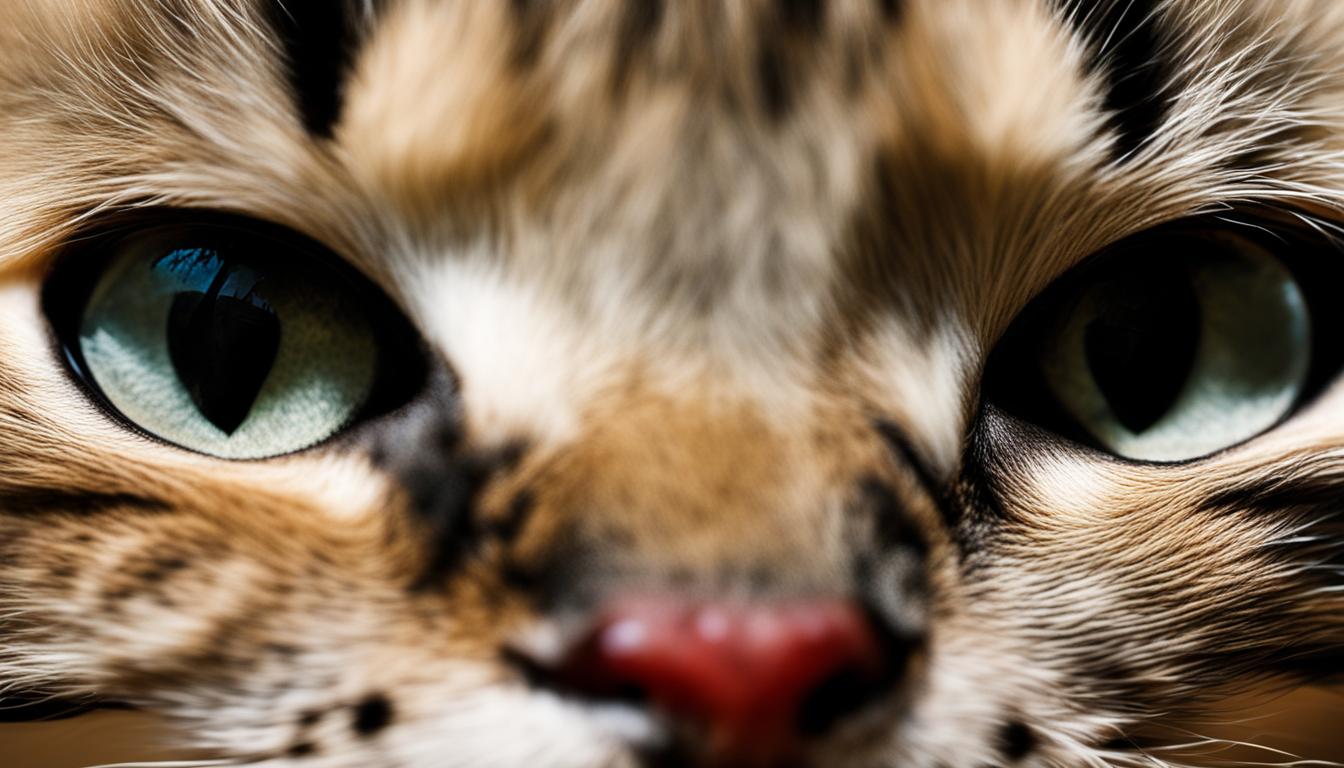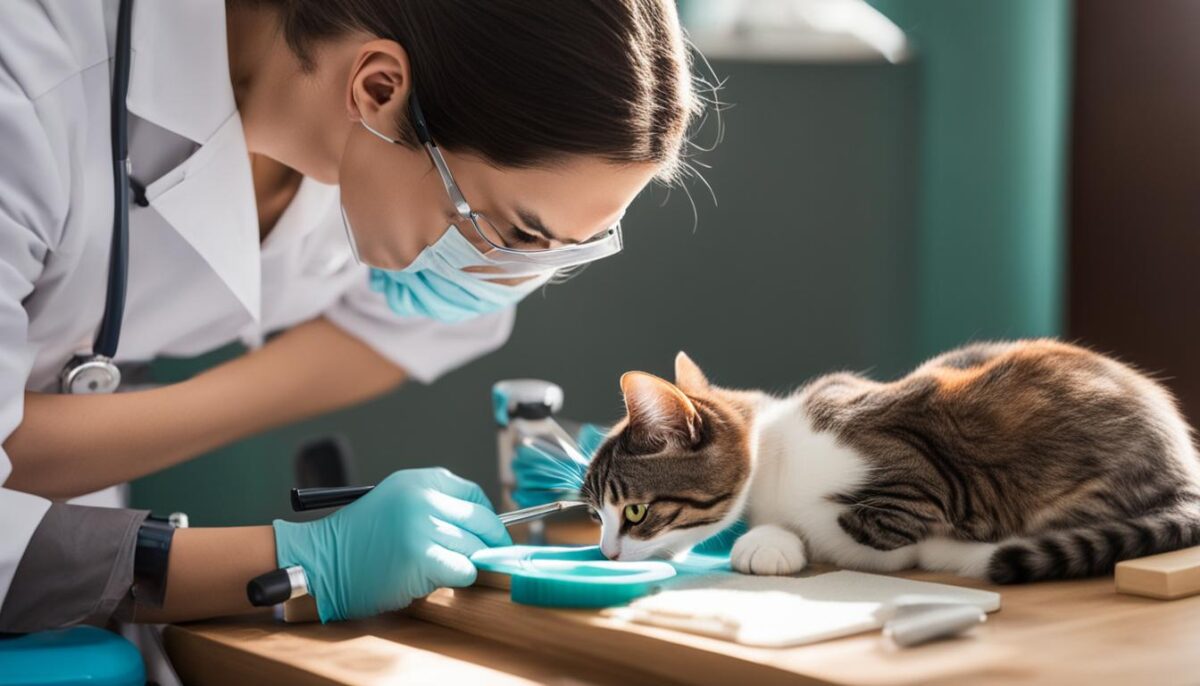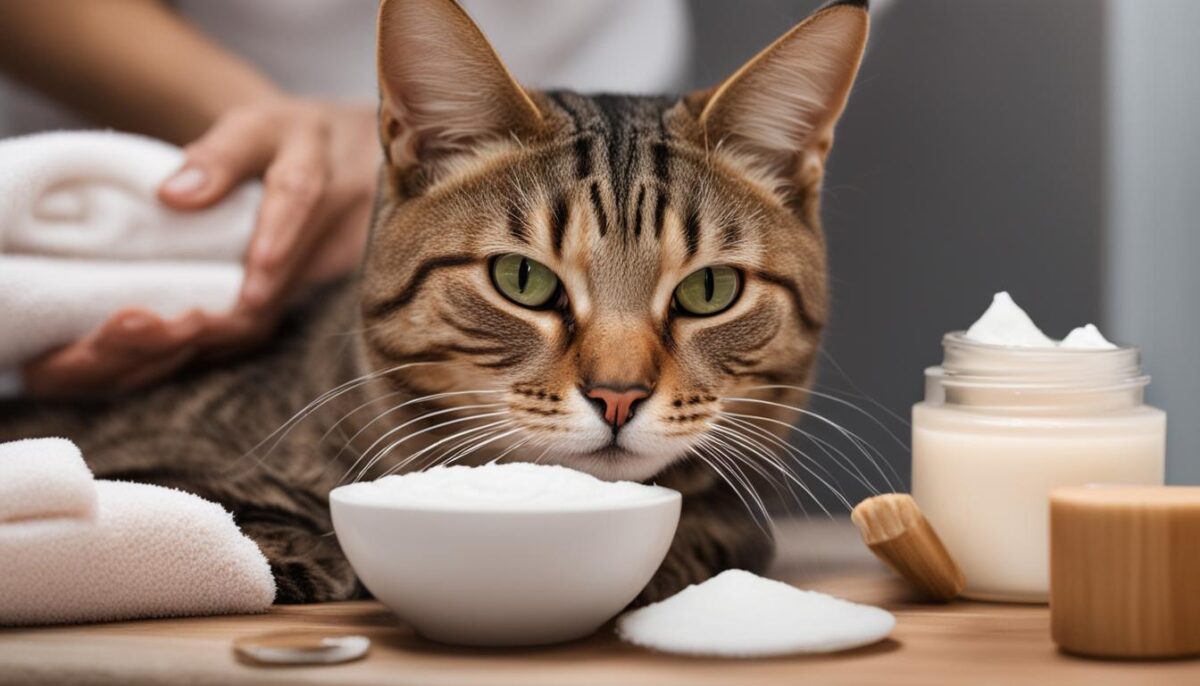Did you know that your furry friend can have skin problems, just like you? Yes, cats can get small bumps on their skin, which are a bit like the pimples people get. This issue is known as feline acne. Don’t worry—it’s a common thing that can happen to cats. These bumps might look like tiny black dots on your cat’s chin and are often called blackheads. Your cat might not tell you if it’s feeling yucky, but by noticing these spots, you can help. If the acne gets out of hand, it can cause bigger sores. So, taking good care of your cat’s skin is a smart way to keep your whiskered buddy feeling great.
Key Takeaways
- Cats can get feline acne, and it shows up as black bumps on their chin.
- These black bumps or spots are also known as cat pimples or blackheads.
- It’s not always clear why cats get this skin problem.
- Keeping an eye on your cat’s skin helps you spot acne early on.
- Feline skin care is an essential part of your cat’s health.
Unveiling Feline Acne and Its Signs
Have you ever noticed your kitty’s chin looking a little dirty or bumpy? That might be something called feline chin acne. Let’s learn what it is and how you can spot the signs!
Think of your cat’s skin having tiny holes called hair follicles. Sometimes, a too-much skin stuff called keratin gets trapped in there. That could be why cats get those funny-looking blackheads. Now, if germs join the party, it could turn those blackheads into pimples. Yikes!
Recognizing the Signs: The Appearance of Cat Pimples
Now, you might see these little black spots mostly under your furry buddy’s chin or around their mouth. They can look a bit like dirt, but they’re actually skin disorders in cats. And sometimes, if you gently touch them, your pet might not like it because it can be sore.
If you’re super curious, let’s make a quick list of what to look out for. Remember, if things don’t look right, a vet could help make your kitty feel better!
- Bumpy or dirty-looking chin
- Small black dots that might seem like dirt
- Area may be tender if you touch it
Can Cats Get Pimples? Understanding the Causes
Have you ever wondered why your furry friend might have those pesky pimples? Cats can develop acne, and there are a few possible causes of feline acne to consider. Just like us, cats can have too much oil on their skin, known as sebum. This might clog their tiny skin pores and cause those bumpy spots.
Some think it could be due to stress, or maybe viruses, that bother their skin. A cat’s immune system plays a big role, too. If it’s not strong enough, it might not be able to fight off the skin problems. Allergies and not cleaning themselves well enough can be causes as well. And, let’s not forget about bacterial infection in cats. Bacteria love to live in tiny cuts in plastic bowls, so it’s a good idea to keep an eye on where your cat eats and drinks from.
Here’s a tip for cat skin care: Switching to glass or metal dishes can be a big help because they’re easier to keep clean and don’t scratch as easily as plastic. It’s a simple change that might make a big difference for your cat!
- Too much natural oil – can lead to clogged pores
- Stress – can affect your cat’s skin
- A weak immune system – might not fight off acne-causing germs
- Allergies – can irritate the skin
- Poor grooming – means more dirt and oil on the skin
- Plastic bowls – scratches can harbor bacteria
The Path to Diagnosis: How Vets Identify Feline Acne
When your furry friend has some spots on their skin, it might be cat acne. Vets are very smart about diagnosing cat acne. They know a lot about vet care for cats. If your cat has spots, the vet will look close at their skin. They will ask about your cat’s health story. This helps them understand what’s going on. Sometimes, a vet does tests to be really sure about the acne.
Feline dermatology is the study of cat skin problems. Vets in this area know just what to do when skin issues pop up. They can tell if it’s just acne or something more by doing skin cultures or skin scrapings. Let’s learn about how vets figure out if a cat has acne or something else.
Conventional Diagnostic Methods for Cat Skin Issues
For simple cases, the vet just uses their eyes and hands. They look at the spots and feel them. They can tell if the skin is oily or if there’s too much gunk in the hair spots. This is the first step in understanding your cat’s skin.
When to Consider Further Testing
If the vet thinks the acne isn’t alone, they do more tests. This helps them find other sneaky problems. If your cat’s mouth is also sore, or if the skin doesn’t look right, the vet might check for a tooth problem or a different skin disease. This could mean taking some tiny parts of skin to look at under a microscope or checking the teeth with an x-ray. The vet will make sure your cat is happy and healthy!
Treatment Strategies for Feline Acne
When your cat has acne, you’ll want to start with good cleaning. This is the first step in treating cat acne. Your vet might suggest using a special wash or shampoo that is safe for cats. Good pet hygiene is very important and can help stop the acne from getting worse.
Topical and Systematic Approaches to Treatment
Your vet can tell you about different creams and gels to put on your cat’s skin. These can help the acne go away. Some cats might need medicine to lower swelling if their acne is bad. It’s like a skincare routine but for your cat!
The Role of Diet and Hygiene in Managing Cat Acne
What your cat eats can also affect their skin. Some vets say giving Omega 3 fatty acids can help. This is a kind of oil that is good for skin health. Also, using better bowls for food and water helps a lot with pet hygiene. Glass or metal bowls are better than plastic because they don’t scratch as easily. This means less chance for acne to start.
| Treatment | Description | How It Helps |
|---|---|---|
| Washing | Using a special wash or shampoo | Cleans the skin and removes dirt |
| Topical Medications | Creams and gels | Fights bacteria and reduces swelling |
| Dietary Supplements | Omega 3 fatty acids | Improves overall skin health |
| Hygiene | Switching to glass or metal food bowls | Keeps eating area clean and bacteria-free |
Conclusion
For a friend with whiskers and a purr, a clean face and good care can make a big difference. Cats with pimples, or feline acne, often feel better when their skin is kept clean. If your cat has spots on their skin, it’s good to do what your vet says. This might mean cleaning their skin carefully, or maybe even changing what they eat to keep them happy and looking good. Remember, for your pet to be a healthy pet, it’s all about the care you give them.
Some cats may need to stay away from things that make their skin unhappy, like flea bites, the whole year. And if little spots on their skin don’t go away with simple cleaning and love, your vet might need to check them more. It’s okay, not all problems go away fast, but by taking the right steps, most cats can wave goodbye to their skin worries.
Taking care of a cat means watching out for bumps on their skin and knowing that feline skincare tips can be very helpful. By managing acne in cats with clean bowls, good food, and lots of care, you make sure they stay cozy and content. So, let’s make sure our precious feline friends are the healthiest pets in our lives!
FAQ
Can Cats Really Have Pimples Like Humans Do?
Absolutely, feline acne is a common skin condition that can result in black bumps resembling pimples on your cat’s chin and other areas on and around their lips.
What Does Feline Acne Look Like?
Feline acne often appears as small black bumps, also known as blackheads or comedones, on a cat’s chin or lip area. These might not be bothersome to your cat initially, but can become irritated or infected if not treated properly.
What Are the Main Causes of Feline Acne?
The causes of feline acne are not entirely understood, but it may be linked to excess sebum production, stress, viral infections, a weak immune system, allergies, poor grooming habits, or the type of bowl your cat uses for food and water. Bacterial growth in small scratches in plastic bowls, in particular, may be a contributing factor.
How Do Veterinarians Diagnose Cat Acne?
Veterinarians usually diagnose feline acne through a physical examination and a review of the cat’s medical history. In some cases, they may perform additional tests such as blood and urine analyses, skin cultures, or skin scrapings to rule out other conditions.
When Should Extra Diagnostic Tests Be Considered for Cat Skin Problems?
If the initial examination and treatments don’t lead to an improvement, or if the vet suspects other underlying issues, further tests such as biopsies or dental x-rays might be necessary to get to the root of the skin problem.
What Are Some Effective Treatments for Feline Acne?
Treatment can include cleaning the affected skin with special face washes or shampoos, applying ointments or gels, reducing hair around the acne, dietary supplements like Omega 3 fatty acids, anti-inflammatory medications, and switching to non-plastic feeding bowls cleaned regularly.
Can Diet and Hygiene Help Manage Feline Acne?
Yes, maintaining good hygiene practices and a careful diet can help manage and potentially reduce the occurrence of feline acne. Using cleaner, non-plastic feeding bowls and monitoring for any food allergies or sensitivities can also be beneficial.
Is Feline Acne a Sign of Poor Cat Skin Health?
Feline acne can be one of several skin disorders in cats that indicate their skin health needs attention. It’s essential to assess and treat any skin problems early to maintain overall health and comfort for your feline friend.
What Are Some Preventative Measures for Cat Pimples?
Preventative measures may include providing a stress-free environment, ensuring regular grooming, offering a balanced diet, avoiding the use of plastic food and water bowls, and routine veterinary check-ups to monitor your cat’s skin health.
When Is It Time to See the Vet for My Cat’s Skin Issues?
If you notice any recurring or persistent bumps, blackheads, or other changes to your cat’s skin, it’s wise to consult with a vet. Early detection and treatment can prevent more severe skin problems and keep your cat comfortable and happy.


